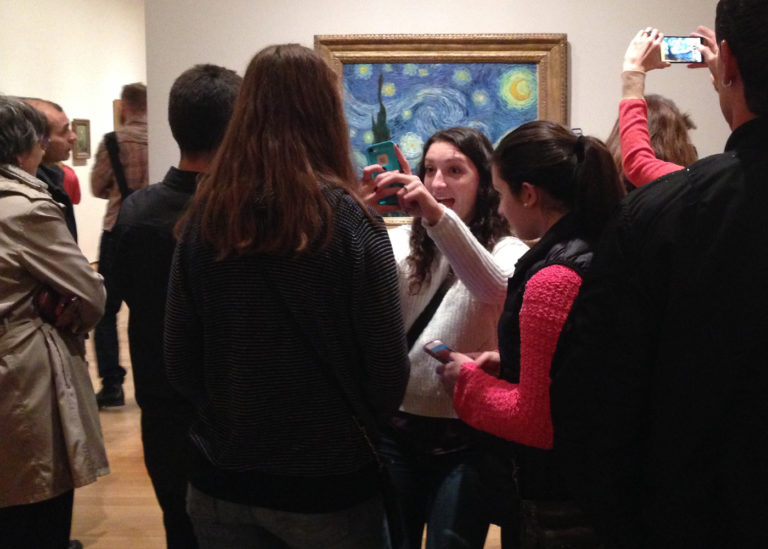Selfies with artworks
Museum of Modern Art
W 53rd St, NYC
Friday 20 March 2015
Some thoughts on:
Selfies with famous artworks
How to display artist’s books / livre d’artiste

The book is … doomed if we can’t even look at a painting
I’m annoying to travel with because I take photos of everything. Everything. This site is evidence that some of this happy-snappery is a useful part of my work. Yet looking at my iPhoto account I’m alarmed that it holds 8,833 photos. Since 2009, but still this seems ridiculous even to me. I didn’t bring my ‘real’ camera on this trip because for my purposes, iPhone photos are fine and past experience shows that I’m much more annoying with a camera capable of delivering high quality images.
I’ll admit to taking photos of artworks in galleries that permit photography. And occasionally ones that clearly don’t. I take these photos to refer to if something about the work seems important enough to spend time considering later. It’s a kind of note-taking for future research.
However, I have never taken a selfie with an artwork. The last thing a incredible work of art needs is my head in front of it. At MoMA there were people lining up – pushing and shoving, a security guard had to remove one man – in order to take a selfie with van Gogh’s Starry Night. I suppose this does at least show some engagement with the work in question – check it out Mum, I was in close proximity to something famous!
More unsettling to me were people zombie-shuffling around the room, in front of each work only long enough to snap it. One man at The Met was doing this without actually looking up from his phone – he engaged with these works only through the screen. Picasso click Matisse click van Gogh click. What will he do with these trophies? Bore his friends with an inventory of every artwork he didn’t actually look at? Will they go on Facebook as proof of cultural tourism?
That said, what will any of us do with our thousands – maybe millions – of banal photographs of meals we captured before tasting, sunsets and streetscapes we snapped in the excitement of a moment we didn’t know how to enjoy without immediately wanting to capture it, with a vague (or very conscious) thought that it would be worth sharing.
In response, here is a series I took called ‘Ash, looking at art’ (sorry, Ash):
















Watching this faux engagement with artworks makes me reflect that the question ‘what is a book?’ is a threshold into more difficult territory: what is reading in a digital age?
If we can’t focus our unmediated attention on a painting for a few moment, how do we expect to concentrate long enough to read a book? If looking is done through a lens, how is reading performed?
The book is … supported by new technology





Throughout MoMA, artists’ books were included in exhibitions. This is unsurprising, considering the legacy left by Clive Phillpot, director at MoMA’s library in the late 1970s, who was an early advocate for the form to be taken seriously by the art world. Phillpot’s work has been continue and expanded by current library director (Bibliographer) David Senior.
According to Senior, the decision to display many of the artist’s books with a touchscreen digital version had nothing to do with the library – the exhibitions are designed by a separate team, and as in many cultural (and academic) institutions, different departments don’t communicate. As far as I could find out, it’s not planned that the digital versions will migrate to either the library or the permanent collection – digitisation in cultural institutions is happening, but not necessarily neatly.
In addition to different departments remaining islands, MoMA keeps the limited edition artist’s books – livre d’artiste, the more ‘fine art’ books – in the main collection, with the ‘multiples’/artist’s books – defined by Philpott as “books or booklets produced by the artist using mass-production methods, and in (theoretically) unlimited numbers, in which the artist documents or realizes art ideas or artworks” – held in the Queens library. Artist books are a wobbly genre.
The touchscreens allow viewers to swipe through high resolution copies of the original books, which are displayed in glass vitrines. Although you can’t ‘read’ the tactile elements of the book (its weight in your hands, the peculiarities of the paper stock) or examine the printing process (important for a work crafted by an artist, the choice of etching/silkscreen/offset printing or other medium can affect the way we interpret the work – think of the difference between seeing a reproduction of a Mark Rothko and a ‘real’ paining).
